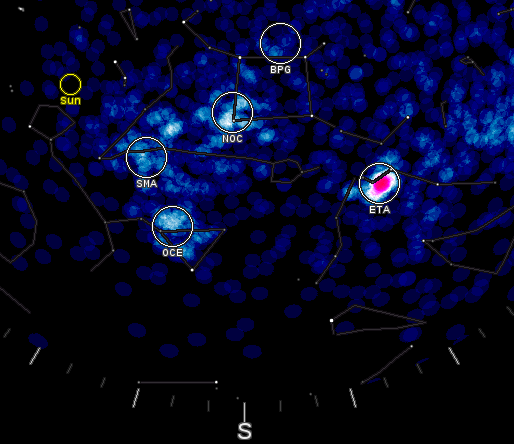Komeet Johnson en aquarid meteorenregen
Komeet Johnson bevindt zich nu binnen ons zonnestelsel en is met een telescoop te volgen.Deze week staat ook in het teken van de aquarid meteroren regen, afkomstig van komeet Halley. Vanaf morgen wordt de regen intenser, durende tot ongeveer vrijdag (kijk naar het oosten).
Komeet Johnson:
Discovered in November 2015 by Jess Johnson of the Catalina Sky Survey, Comet Johnson (C/2015 V2) is now swinging through the inner solar system on a hyperbolic orbit. A "hyperbolic orbit" means the sun's gravity will probably fling the comet into deep space later this year. Now is the time to look. Amateur astronomer Rolando Ligustri used a remotely controlled telescope in New Mexico to photograph the comet on May 1st:
© Rolando Ligustri
Ligustri's 2 x 10 minute exposure with a 4-inch telescope reveals the comet's green nucleus and its double tail. The longer of the two is the filamentary ion tail, made of gas carried directly away from the sun by the solar wind. The shorter protuberance is the bright dust tail, made of dusty-rocky grains sprinkled like crumbs along the comet's orbit. Comet Johnson's nucleus is green because it contains diatomic carbon (C2) a substance that glows with a verdant hue in the near vacuum of space.
This comet is not visible to the naked eye, but as it approaches Earth for a 0.81 AU close encounter in early June, it is brightening to ~6th magnitude, making it an easy target for backyard telescopes. Northern hemisphere observers are favored in early May, when the comet dwells in the constellation Hercules; in late May and June, Comet Johnson races toward southern skies, where observers south of the equator can watch the comet continue its journey toward the sun.
Aquarid meteorenregen, afkomstig van komeet Halley:
According to Canada's Meteor Orbit Radar (CMOR), a "hot spot" has appeared in the constellation Aquarius. This is a sign that the annual eta Aquarid meteor shower (ETA) is underway. This sky map shows where the radar detected pings from incoming meteors in broad daylight on May 2nd:
These meteors are pieces of Halley's Comet, hitting Earth's atmosphere at 66 km/s and disintegrating ~100 km above Earth's surface. In the days ahead our planet will cross a network of debris streams from the comet, producing a drizzle of eta Aquarids numbering 10 to 30 meteors per hour in the northern hemisphere and perhaps twice that number in the southern hemisphere.
Two leading meteor forecasters have noted the possibility of eta Aquarid outbursts. Mikhail Maslov says meteor activity could increase on May 4th (14h- 18h UT) when Earth grazes a dust trail released by Comet Halley in the year -616. Forecaster Mikiya Sato agrees that that Earth could encounter the -616 dust trail, but later on May 5th (05h - 15h UT), possibly with such a gentle graze that no special increase is detectable. In most years the strongest activity is seen around May 6th, which may still prove true in 2017.
The best time to look, no matter where you live, is during the dark hours just before dawn when the constellation Aquarius is rising in the east.
Bron: http://www.spaceweather.com/

©Eliot Herman
"With clear skies this week, the hunt for eta Aquarids is on," says Herman. "This photo is from an all night series of fisheye images taken with a Nikon D810 at 15 sec each, ISO 3200."
Forecasters expect the shower to peak on May 5th and 6th with 10 to 30 meteors per hour visible from the northern hemisphere, and twice that number from the southern hemisphere. No matter where you live, the best time to look is during the dark hours before local sunrise when the constellation Aquarius is rising in the east
Bron: http://spaceweather.com/

As the meteors passed over Europe, they were illuminated by signals from France's GRAVE space surveillance radar, used by the French government to track Earth-orbiting satellites. The meteors added an extra set of echoes not normally present. Using a Yagi antenna and a radio receiver tuned to 143 MHz (the operating frequency of the radar), the astronomers in Germany listened to the activity.
"We detected very powerful echoes, very much stronger after midnight," says Böhme. "The Doppler effect (caused by the rapid motion of the meteors) was very good to hear." They also detected radar reflections from the Moon. "Coincidentally, the Moon was within the beam of our antenna and we could receive 'moon-bounce' echoes as well."
Meanwhile in Puerto Rico, amateur astronomer Frankie Lucena experienced the shower the old-fashioned way--by looking. "I was facing south from Cabo Rojo at 4:56am on May 5th when I saw this meteor," says Lucena. "It was a beauty."

© Frankie Lucena
The display should continue on May 6th and possibly the 7th as Earth continues its passage through a broad stream of debris from Halley's Comet. Forecasters expect 10 to 30 meteors per hour in the northern hemisphere, and perhaps twice that many in the southern hemisphere. The best time to look, no matter where you live, is during the dark hours before local sunrise.
Bron: http://www.spaceweather.com/

 Komeet Johnson en aquarid meteoren regen
Komeet Johnson en aquarid meteoren regen




